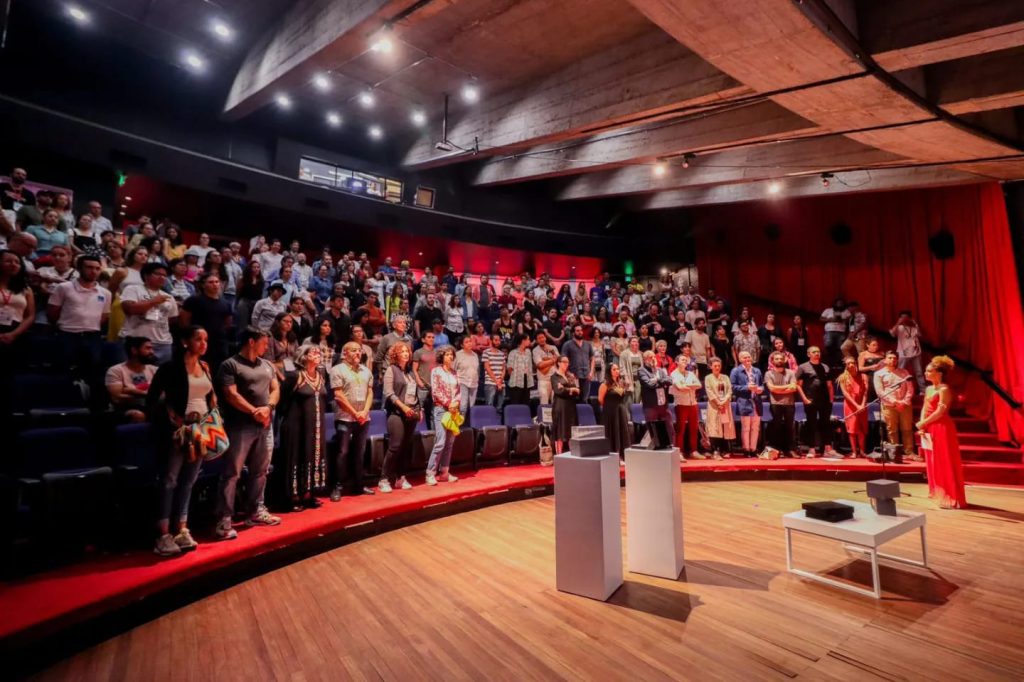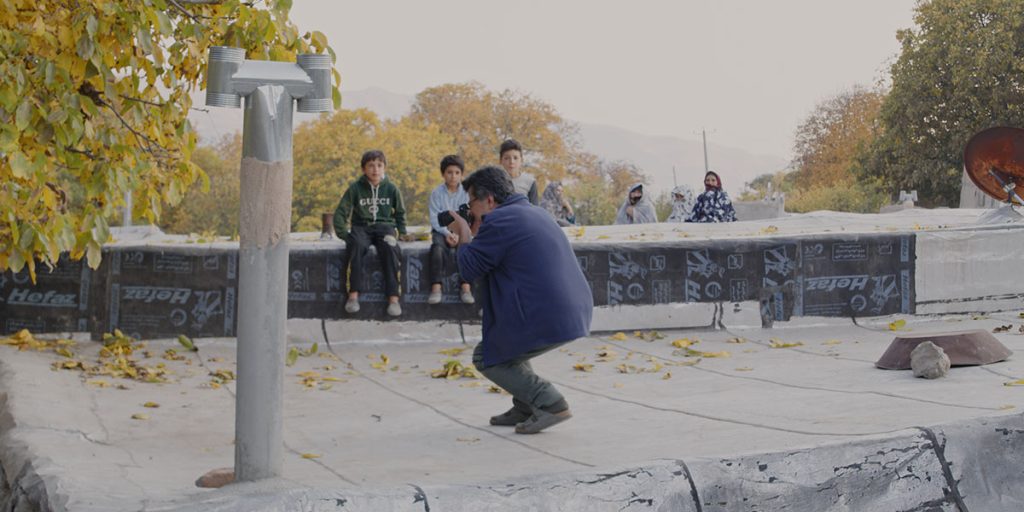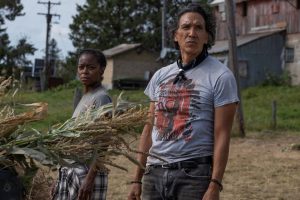Reviews include 40 Acres, Jurassic World: Rebirth, and Sorry, Baby.
FICCALI Thrives Under New Direction from Diana Cadavid
November 18, 2022

By José Teodoro
I’ve had the good fortune to attend film festivals in different countries. I favour smaller ones that foster a sense of community, both locally and among visitors from abroad: a community anchored by a shared love of cinema. If I’m lucky, at such festivals I get to see interesting movies I wouldn’t encounter otherwise. If I’m lucky, I meet good people, attend fun parties, find a lecture or workshop conducted in a language I understand. At the 14th Festival Internacional de Cine de Cali, or FICCALI, I found all these in abundance, especially the sense of community.
Cali is a city of modest size, a place to stop on route to Colombia’s interior when traveling from the Pacific coast. But Cali has become many different things, among them “la capital de la salsa,” a city of people displaced by violence, a site of explosive political activism, and—the part you mightn’t have known—a vibrant hub of cinephilia. While Bogotá is clearly the centre of Colombia’s film industry, it’s said that Cali produces more filmmakers per capita. Caleños love to watch, discuss, celebrate, and argue about movies. And to party.
I was invited to FICCALI to sit on a jury with filmmakers Nicolás Pereda, winner of the TFCA’s 2012 Stella Artois Jay Scott Emerging Artist Award, and Diana Bustamante, probably best known as the lead producer on Apichatpong Weerasethakul’s Colombia-set Memoria. Our competition consisted of a dozen international features evenly split between smaller Latin American films from lesser-known directors and what you might call art-house tentpole films from festival-circuit darlings, such as Albert Serra. The selection was strong for a festival of this size and the screenings well-attended. We were pleased to give one award to Herbaria, Argentine director Leandro Listorti’s lovely essay film about plants, preservation, and archives, and one to Jafar Panahi’s No Bears, an exquisite fusion of fiction and factual circumstance that finds Panahi playing a version of himself—which is to say, an Iranian filmmaker whose government continues to constrain his movement in ways that make it nearly impossible to make films. Unable to cross the border, the protagonist travels to a northern village to remotely direct a production transpiring in Turkey. It’s a story about longing, myriad frontiers, and the coded intricacies of language and custom. It is wildly imaginative, extremely funny, and profoundly moving.
Seeing films at FICCALI was a pleasure. Being invited to a different party every night, all of which involved great music, dancing, and copious amounts of aguardiente: also a pleasure. But what made the festival feel truly special were the events in its “Cine Sin Límites” and “Agenda Académica y de Industria” sections: special screenings, panels, and masterclasses that were simultaneously totally relaxed and totally focused. On the festival’s first night, I saw León Simiani’s 31-minute El syndrome de los quietos, a faux-documentary told from the future, which, among other things, uses the eerie silences of the early days of the pandemic as a way to think about the inherent noisiness of Colombians whenever they determine to enact change. The influence of Chris Marker is obvious, but just as important to the film’s genesis was the example set by Luis Ospina, the late caleño filmmaker and FICCALI’s founding director. Ospina appears in the film and his legacy was the subject of a fascinating and affecting post-screening discussion involving Simiani, caleño filmmaker Óscar Campo, and visual artist—and Ospina’s widow—Lina González. Ospina is probably best known in Canada for It All Started at the End, his epic portrait of “Caliwood,” which had its world premiere at the Toronto International Film Festival in 2015, four years before Ospina’s death at age 70. Ospina’s ghost is everywhere in caleño film culture. But it must be said that if you come to FICCALI knowing nothing of the city’s film culture, you won’t feel late to the party. This party never ends, and, in pure caleño style, everyone is invited.
A Circuitous Education
If I were to guess what makes the present iteration of FICCALI so distinctly alluring, I’d give some serious credit to its current director, the dynamo known as Diana Cadavid. She is TIFF’s international programmer: Latin America, Spain, Portugal, and Latine diaspora, the director of the Los Angeles Latino International Film Festival, or LALIFF, and a filmmaker herself, credited with varied production roles on films directed by Álavro Girón and Lina Rodríguez. She is one of the most resourceful people I know. One way to get a sense of what’s happening at FICCALI is to consider Cadavid’s story of leaving and returning to Cali.
Born and raised caleña, Cadavid attended Cali’s Universidad del Valle to study, of all things, electrical engineering. Her passion for film was kindled upon meeting Girón, who introduced her to Cali’s thriving cinephile scene, which emerged in the 1970s thanks in large part to the furiously prolific writer and impresario Andrés Caicedo, who founded both the magazine Ojo con el cine and Cali’s Cinema Club while publishing dozens of works in various genres before taking his own life at age 25. Caicedo’s enthusiasm inspired a generation of scholars and archivists committed to rescuing and documenting an endangered cultural history.
Cadavid quickly lost interest in engineering, immersed herself in film and art, and threw stones at police. By the late 1990s and early 2000s, Colombia had long been mired in violence, corruption, and internal displacement, and Cadavid was a passionate activist. But she became disenchanted at the Left’s failure to enact change. Meanwhile, being a public institution, strikes were frequent at Universidad del Valle. During Cadavid’s enrollment, a strike began that lasted over six months. Girón went to Bogotá for an internship and Cadavid quit her studies to join him. She worked in a bookstore and planned to attend the Universidad Nacional to major in either physics or philology. Then her sister, who lived in Miami, received a cancer diagnosis. Cadavid dropped everything and flew to Florida.

Back home, Álavro Uribe was elected as Colombia’s President and, with the generous support of the U.S. government, launched a full-scale military offensive against Leftist guerrilla groups, such as the Revolutionary Armed Forces of Colombia, or FARC. Girón was documenting displacement and war, and he was told to focus his energies elsewhere. It was a bleak period, with citizens denouncing each other. Once her sister’s situation had stabilized, Cadavid made a decision. On Christmas Eve 2004, she flew to Buffalo, crossed the border into Canada, and applied for refugee status, something she didn’t take lightly. “When you come from a country where people are killed in the street,” she told me, “it’s hard to believe you deserve this.”
Cadavid had heard of the aluCine Latin Film and Media Arts Festival and thought if she could get one of Girón’s documentaries programmed there, he could join her in Toronto. She visited aluCine’s director, filmmaker, and fellow caleño Jorge Lozano, who, even before looking at her cache of VHS screeners, offered her a volunteer position, which was swiftly followed by an honorarium in exchange for organizing print traffic, a job Cadavid didn’t know existed. She became enamoured with film exhibition, considered becoming a projectionist, and fell in love with the community that welcomed her. Throughout that first Toronto winter, she was frequently invited to Lozano’s home, where he prepared huge meals for a burgeoning group of Latin American expats and artists, among them Lina Rodríguez. AluCine invited Girón’s The Air They Breathe, a documentary about the music scene in Colombia’s port town of Buenaventura. Girón’s visa was approved.
Cali Calls Cadavid Home
Cadavid worked at a Colombian restaurant that’s since closed—this is where she and I met—and started another degree, this time in film production at York University. This, too, was aborted. “I don’t finish undergrads,” Cadavid declares with a laugh. “That’s the rule.” Instead, she was offered a programming assistant gig with Diana Sanchez, former senior director of film, at TIFF. She took the short contract, believing it was cool, though hardly grounds for a sustainable career. But the TIFF job led to a position with the nascent International Film Festival Panamá, where Sanchez was artistic director. Suddenly, Cadavid was working for festivals almost year-round. What’s more, Panamá was a small but important regional festival, showcasing films from Central and South America alongside international art-house hits. Cadavid got a sense of how the larger festival apparatus functioned—and how someone with her patchwork resume could find a place in this part of the film world.
By 2019, Cadavid was working as associate director of programming for the Miami Film Festival. She was miserable. She’d relocated to Florida for what seemed like a lateral career move, only to find that the festival was organized in such a way that she was granted limited access to stakeholders and artists. She felt she was becoming invisible. “In this industry,” she tells me, “unless you keep traveling and people keep seeing you, you disappear.” Then, out of the blue, she gets a WhatsApp message telling her that since Ospina’s passing, a hiring committee has unanimously decided to invite Cadavid to be FICCALI’s next director. “I was shocked,” says Cadavid, who hadn’t lived in Cali for nearly 20 years. “I didn’t know that anyone in Cali knew I existed.” She knew she had to do this—and that she had to quit Miami—but her salary with FICCALI was going to be in Colombian pesos, with no chance of her making enough to survive.
Then—again, out of the blue—Sanchez called. She recommended Cadavid for the role of director of the Los Angeles Latino International Film Festival, but Cadavid would need to be ready to be interviewed the next day. The interview went well, but then she needed to get to Austin, where she’d meet Mr. Olmos. (That Olmos being LALIFF founder and Oscar-nominated actor Edward James.)
Cadavid explained that, snowed with responsibilities for Miami, she couldn’t go, but she made a promise: as soon as Miami ends on March 15, she’ll pack her bags, do her post-mortem, quit, then fly directly to Los Angeles. In the meantime, she’ll start working for LALIFF remotely and clandestinely. Mr. Olmos said that if Sanchez vouches for her, she’s hired. In the end, Cadavid didn’t have to wait until March 15: the world shut down two days before. Cadavid got LALIFF through its first pandemic, launching one of the world’s first virtual festivals. When that wrapped, she headed down to Cali.

A New Vision
Under Cadavid’s stewardship, FICCALI’s selection has actually gotten smaller, screening fewer, better films, spreading them across a more manageable schedule, and ultimately increasing attendance for individual screenings. Cadavid felt that previous editions had been too Eurocentric, so she sought to create a space for more films from woefully underserved Indigenous and Black communities—Afro-Colombians make up over 10% of the country’s population—or from developing industries, while the “Cali: Ciudad Abrieta” program showcases regional productions. She also feels that vying for premiere status is detrimental to the festival’s life. “What do I care if a film already premiered in Cartagena?” Cadavid explains. “I want to create a network between festivals, a way of cooperating that serves the filmmakers and brings films to audiences, including audiences who live in remote, historically neglected areas of this country that tends to give all its cultural resources to the capital.”
The fiscal challenges are, of course, tremendous. “For me to bring No Bears here, I have to pay 800 euros,” Cadavid explains. “What that means in Colombian pesos is a crazy amount of money. And with the particular challenges we face with regards to marketing and communication, that film is likely to be seen here only by people who already know why this film matters. If we want these films to find more viewers, we need to find ways to share costs on things like subtitles and screening fees.” Thus, instead of competing with other festivals, FICCALI is trying to develop a network of sister festivals, such as Muestra Cinema Documental Bogotá, with whom FICCALI was able to share travel costs for two visiting foreign filmmakers. Such strategies might be the only chance of festivals like FICCALI to survive in an ever-shifting industry that, like most industries, is threatened by shortages, inflation, climate change, and political unrest.
In the end, Cadavid sees FICCALI thriving by working in harmony with both the local and international communities. She hopes that this peripatetic career that’s found her moving all over the Americas will support her vision. “I try to find stories that resonate with the way I see Cali,” Cadavid explains. “I’m from here. I have the knowledge and I understand the codes. At the same time, I’m from another place, a more privileged place. How can that privilege translate into something exciting for Cali? And, in turn, how can I help make Cali an exciting place for everyone else?”



